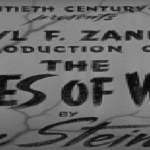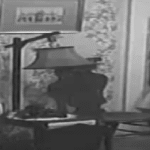The 1939 animated film Gulliver’s Travels, produced by Max Fleischer and directed by his brother Dave Fleischer, is a whimsical and musical adaptation of Jonathan Swift’s classic 1726 novel. As the second American feature-length animated film after Disney’s Snow White and the Seven Dwarfs (1937), Fleischer Studios aimed to create a visually enchanting and narratively rich work. The result is a colorful, light-hearted reimagining of Swift’s satirical tale—one that trades biting political commentary for a story of romance, misunderstanding, and eventual unity.
The film opens with a dramatic storm at sea. Amid crashing waves and howling wind, a ship is torn apart, casting its lone survivor, Lemuel Gulliver, onto the shores of an unfamiliar land. The next morning, Gulliver, a towering figure compared to his surroundings, is discovered by a tiny man named Gabby, a well meaning but bumbling town crier. Gabby runs off in a panic to inform the kingdom of Lilliput of the giant who’s washed ashore.
Lilliput is a miniature kingdom, lively and colorful, where the people are in the final stages of preparation for a royal wedding between Princess Glory of Lilliput and Prince David of the neighboring kingdom of Blefuscu. Their union is meant to symbolise peace between the two rival nations. However, tensions erupt over a seemingly trivial matter: which song will be sung at the wedding. King Little of Lilliput insists on “Faithful,” his kingdom’s anthem, while King Bombo of Blefuscu demands that “Forever,” Blefuscu’s anthem, be played instead. This disagreement escalates into a full-blown diplomatic crisis, threatening to reignite war between the two realms.
Amid the rising tensions, the discovery of Gulliver throws the tiny kingdom into chaos. The Lilliputians initially fear Gulliver, binding him with ropes as he lies unconscious on the beach. But as he awakens and reveals himself to be gentle and reasonable, the townspeople begin to trust him. His immense size and strength, they quickly realise, could be useful in defending the kingdom, or perhaps preventing war entirely.
As the kingdoms prepare for battle, King Bombo of Blefuscu orders his navy to prepare an assault. Meanwhile, Gulliver is brought to the capital and treated with awe and curiosity. He tries to mediate between the quarreling kings, advocating for peace and unity rather than conflict. Gulliver befriends Princess Glory and Prince David, encouraging them to sing their love duet, which blends both national anthems into a single harmonious song. This symbolic gesture is key to resolving the dispute.
While Gulliver serves as a benevolent giant in the land of Lilliput, Gabby becomes a comic relief figure, constantly overestimating his bravery and authority. His antics provide a contrast to the more serious themes of misunderstanding and pride that fuel the conflict between the kingdoms.
One of the central themes of the film is how small grievances, when left unchecked, can escalate into major divisions. The absurdity of the kings’ argument over a song satirizes the pettiness of political disputes. Though the film tones down the biting satire of Swift’s original work, it preserves the underlying message that unity and compromise are essential to peace.
The climax of the film sees Blefuscu’s fleet attacking Lilliput under cover of night. In a thrilling and visually impressive sequence, Gulliver intervenes, effortlessly lifting the ships out of the water and rendering their weapons useless. His intervention is not violent; rather, he neutralizes the threat with compassion and intelligence, emphasizing peace over force. His actions awe both kingdoms and force the kings to reconsider their positions.
Moved by Gulliver’s words and the display of unity in the prince and princess’s song, both kings relent. They realize that their stubborn pride nearly led to needless bloodshed. The film ends on a hopeful note as the two kingdoms come together to celebrate the wedding, their differences reconciled through understanding and love.
Musically, Gulliver’s Travels leans heavily on original songs to convey emotion and advance the plot. “It’s a Hap-Hap-Happy Day” and “All’s Well” are two standout numbers that blend cheerful melodies with period appropriate orchestration. These songs, performed by the Lilliputian chorus or Gabby, help define the tone of the film, light, optimistic, and innocent, even amidst the looming threat of war.
Visually, the film is ambitious. Fleischer Studios employed the rotoscope technique (which they invented) to animate Gulliver realistically, basing his movements on live-action reference footage. This contrasts with the more cartoonish designs of the Lilliputians, creating a striking visual juxtaposition between Gulliver and the miniature world he inhabits. The backgrounds are lush and painterly, evoking a storybook quality that enhances the fantasy setting.
The character of Gulliver is portrayed as wise and kind, serving as a moral compass within the film. Unlike the more satirical or ironic versions of Gulliver found in other adaptations, this version casts him almost as a fairytale hero—calm, rational, and physically powerful, yet never domineering. He represents the best of human nature, displaying reason, empathy, and diplomacy.
Upon its release, Gulliver’s Travels was both a technical achievement and a commercial success. Though it didn’t reach the critical acclaim of Snow White, it proved that feature-length animated films had a future beyond Disney. It helped solidify animation as a serious art form and showed that storytelling in this medium could appeal to both children and adults.
However, it also marked a high point that would prove difficult for Fleischer Studios to sustain. Despite its success, the film’s production challenges and costs contributed to financial pressures that eventually led to the studio’s decline. Still, Gulliver’s Travels remains a significant milestone in animation history, an early experiment in blending storytelling, music, and visual style in a full-length animated feature.
In the end, Gulliver’s Travels is a tale of reconciliation and perspective. By showing how a “giant” can help small-minded people see the bigger picture, it offers a timeless lesson: that wisdom and kindness are mightier than swords and pride. Though softened from its source material, the film retains enough of Swift’s spirit to inspire viewers to consider how easily disputes arise, and how simple they can be to resolve when approached with an open heart.







